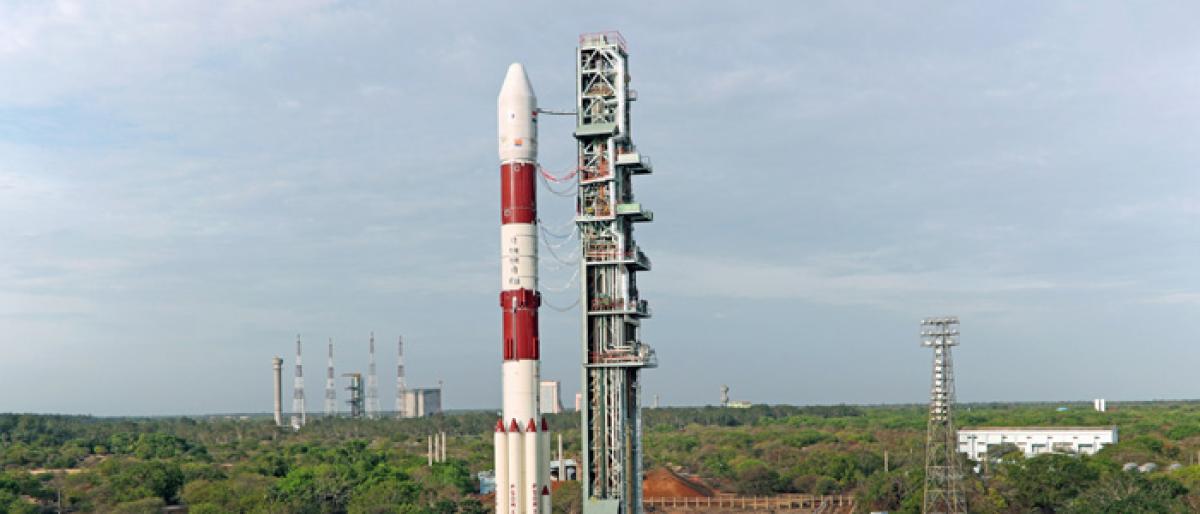Live
- Over 7,600 Syrians return from Turkiye in five days after Assad's downfall: minister
- Delhi BJP leaders stay overnight in 1,194 slum clusters
- Keerthy Suresh and Anthony Thattil Tie the Knot in a Christian Ceremony
- AAP, BJP making false promises to slum dwellers for votes: Delhi Congress
- 'Vere Level Office' Review: A Refreshing Take on Corporate Life with Humor and Heart
- Libya's oil company declares force majeure at key refinery following clashes
- Illegal Rohingyas: BJP seeks Assembly session to implement NRC in Delhi
- Philippines orders full evacuation amid possible volcanic re-eruption
- Government Prioritizes Welfare of the Poor, says Dola Sri Bala Veeranjaneyaswamy
- Two Russian oil tankers with 29 on board damaged due to bad weather
Just In

After many a record last year, Isro took off in the new year with a splendid launch of its 100th satellite, along with 30 others including 28 from foreign agencies aboard PSLV-C40 on January 12. On Thursday, it added another feather to its cap. The successful launch of a 2,066 kg high power S-band communication satellite GSAT-6A
After many a record last year, Isro took off in the new year with a splendid launch of its 100th satellite, along with 30 others including 28 from foreign agencies aboard PSLV-C40 on January 12. On Thursday, it added another feather to its cap. The successful launch of a 2,066 kg high power S-band communication satellite GSAT-6A by a 415.6 tonne and 49.1 metre GSLV Fo8 will take India's communications to next level, especially in satellite-based mobile communication applications including handheld terminals. Security forces and remotest corners of the country will also benefit immensely.
Geosynchronous Satellite Launch Vehicle, dubbed ‘Naughty Boy,’ is India's largest indigenous launch vehicles. And GSLV-F08 is its 12th flight. It also marks the sixth flight of GSLV with a critical indigenous cryogenic upper stage. The fourth generation launch vehicle has since January 2014 completed four successful missions. Isro has taken upon itself the stupendous task of various launches this financial year: three earth observation satellites, four PSLV launches and flights of GSLV's heavy weight MkII and MkIII vehicles. The government decision to lay thrust on S-band is quite apt. The S-band (2-4GHz) is more compatible for use by weather radars, ship radar and communications, more so for 4G services.
Needless to say, India's growing defence needs in wake of threatening postures by China and Pakistan will be met greatly by the newest satellite which cost Isro about Rs 270 crore. Isro has come a very long way from 1983 when it launched the first Insas satellite that triggered communications revolution in the country, with the onset of TV and radio broadcasting, telecom and meteorology.
Also, the launch success greatly boosts the morale of Liquid Propulsion Systems Centre (LPSC) which developed all-important Vikas engine which passed the test with flying colours. This high-thrust engine will be used to propel India's next lunar mission, Chandrayaan-2. India's second mission to the moon, in the 10th anniversary of maiden flight to the moon, originally tentatively planned for April, has been put off to October. Vikas is to help put around a 3.3 tonne spacecraft in the lunar orbit.
By mid-2018, Isro will have put 250 Indian and foreign satellites in the space. A new imaging satellite with a spatial resolution of 50m-1.5km is also slated for takeoff this year. Oceansat-3 is set to help India measure accurately ocean colour and sea surface temperatures. Not lagging behind in meeting dynamic needs of other sectors, Isro is making Risat-1 to improve studies in agriculture, soil moisture, hydrology and oceanography.
On the back of its tremendous launches, Isro is making some serious money in the global space market. Sometime back, it had orders worth ₹400 crore and is in talks for more orders that could touch Rs 600 crore. Its involvement with private sector will hopefully see more of India's bright minds joining its spatial odysseys. India's illustrious space agency is entering golden jubilee next year. Kudos to its scientists for meeting its vision of harnessing space technology for national development while pursuing space science research and planetary exploration!

© 2024 Hyderabad Media House Limited/The Hans India. All rights reserved. Powered by hocalwire.com







